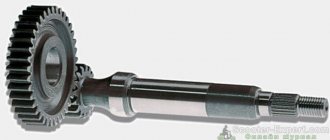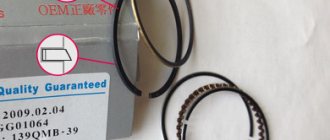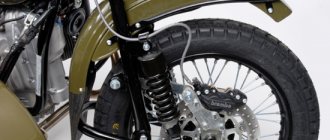GENERAL CHARACTERISTICS OF THE PROBLEM
If your motorcycle is in good working order, then the exhaust is nothing more than a combination of water and carbon dioxide. Without impurities and additional components. However, in the case of fuel combustion, we are not dealing with pure oxygen, but with diluted nitrogen.
The color of smoke from a motorcycle muffler can be different: white, black and even blue. By its shade we are able to determine the nature of the breakdown. Often, smoke appears with other signs of malfunctions that are not noticed at first. This is the first sign that a serious breakdown is soon possible. And it needs to be excluded.
The problem is that even the most modern motorcycles experience incomplete combustion and oxidation of fuel. Accordingly, more CO and CH come out. Because of this, when changing fuel, a change in the color and consistency of exhaust smoke may be observed. In addition, sometimes oil or coolant used gets into the combustion chamber, which gives off its chemical compounds and is thrown out.
Another common cause is the wear and tear of the filter system. No matter how carefully you treat your motorcycle, filters perform their functions worse and worse over time. Therefore, if changes in the color of the exhaust are observed, perhaps replacing the filters will be the simplest solution to the problem. However, the matter may be completely different. Let's consider different options and possibilities for solving the problem.
In most cases, white smoke is a common occurrence in winter when you warm up your motorcycle in the morning. And almost always it is not smoke, but ordinary steam. Due to the temperature difference in the exhaust pipe, condensation always forms when it cools, after which it freezes until the next time the motorcycle warms up. When you start the car, the exhaust pipe also begins to heat up, melting the frozen condensate and turning it into a gaseous state. In this case, water may also drip from the pipe, which is also not a serious problem in this case. And the colder it is outside, the more noticeable the smoke is. Yes, and humidity plays a role. The higher it is, the thicker the white steam.
But what to do when the exhaust of an unusual color from the muffler is observed non-stop even in warm summer weather? This phenomenon is primarily associated with the penetration of liquid into the cylinders. As a rule, these are coolers: antifreeze, antifreeze or even plain water. In this case, there is a chance that you need to replace the cylinder head gasket. The moisture does not evaporate completely and smoke with a high density is formed. Characteristic is the fact that the color and density of the exhaust can vary greatly depending solely on the type of coolant. Low quality and cheap in itself can cause a lot of trouble.
In order to better understand the nature of white smoke, you need to carry out diagnostics. It mainly occurs due to problems in the cooling system. If there is a hint of its malfunction, we strongly recommend that you carry out a series of checks. First of all, you should make sure that the liquid is evaporating from the muffler. Warm up the engine to its usual operating temperature (the procedure can be carried out even after some travel). Find a clean piece of paper and apply it to the pipe, partially blocking the hole with it.
We draw conclusions: if it is water, it will turn into steam, without leaving behind any greasy, oily traces; if there are greasy stains on the sheet, there is clearly a problem in the system.
If the sheet is clean, we continue the search. The problem of moisture ingress may lie not in the gasket itself, which due to certain factors was damaged, but also in cracks in the cylinder blocks. They can usually be detected without problems upon careful examination.
There is another fairly common reason for the appearance of white smoke - the engine does not have time to warm up. If you drive a little and over short distances, condensation accumulates more and more and does not have time to escape. As a result, the exhaust may become so clogged with condensate that the car simply will not start. To avoid this, we recommend that you fully warm up the motorcycle at least once a day, and if possible, use auto-warming.
But detected problems, which are accompanied by white smoke from the muffler, do not just require urgent elimination of their causes. They require careful inspection and elimination of defects in the cooling system, since, as practice shows, they are caused by engine overheating. There is a possibility that the thermostat is faulty or the switch is not working, the radiator is not sealed, etc.
To summarize, we can say that in winter you should not particularly focus on the appearance of white smoke. The problem solves itself with the arrival of heat without your participation.
Oil getting into the cylinders is the most common reason for its regular appearance. The smoke itself can have a whole range of different tones: from unclouded bluish to a rich bluish tint. The blue smoke does not immediately dissipate in the air, and when performing a test with a piece of paper, dirty, oily droplets are left on it, which come out along with the exhaust gases. There are several key reasons for the blueness of smoke:
- Damage to valve stems, guide bushings and wear of valve stem seals. They noticeably increase the amount of smoke while the engine warms up.
- Excessive oil consumption is observed in engines that have a turbocharger. Cause: A faulty turbocharger, which you will most likely need to replace.
- Malfunctions of the ventilation system. Its task is to separate the oil and adjust the flow rate. It needs to be reconfigured or replaced.
- When blue smoke appears from the muffler, you must closely monitor the oil level so that it is normal, and be sure to monitor the serviceability and suitability of the piston group parts.
If you notice that oil is being consumed faster than usual, this is a clear sign of a ventilation problem. The cost of replacement is low, so there is little point in repairing it. It's easier to buy.
Why does a 4t scooter (four-stroke) smoke?
Here things are already a little different.
The nature of a four-stroke engine is determined by the lubrication of parts in a separate oil bath, which is in no way connected with the combustion chamber. The obstacle, in this case, is the oil scraper rings, which actually prevent the oil from burning along with gasoline. The cause of smoking in a four-stroke engine is most often the presence of oil scraper rings in the piston groove or its wear. Now it does not remove oil from the cylinder walls during operation, and with each power stroke, part of the lubricant burns at top dead center. Naturally, this is a breakdown that needs to be fixed. Sometimes, many people confuse steam from the exhaust pipe with smoke. Water in the form of steam is a sign of high humidity in the exhaust system. In an unheated exhaust system, moisture from the air partially condenses and becomes visible, and water usually appears at the cut of the exhaust pipe. And as the system warms up, condensation and steam disappear. This is a common occurrence.
Source
RE: Smokes for 10 years 7 months. back #6369
- EVV
- Off site
- Expert
- I had a TTP.
- Kawasaki KLE 400 Yamaha YZ 125 cross
- Posts: 268
- Reputation: 22
EEE, slow down. If you give a guy some advice, he'll blow his head off once or twice.
What you are describing is completely normal. At relatively low temperatures (at night it is still minus, and the motorcycle cools down overnight), when starting on a cold engine, oil consumption increases (it is thick and enters the combustion chamber). It begins to burn with blue smoke + white steam from the cold insides of the exhaust pipe. Place your hand near the exhaust, if there are no separate drops of oil on it in large quantities (oil + water is allowed in small quantities), then everything is fine. If, when the engine warms up to 1/4-1/3 operating temperature, everything returns to normal and there is no smoke, everything is OK.
If it smokes on a hot engine and the smoke especially intensifies (like a steam locomotive) at rpm, use the caps. One reputable service FOUGHT for a whole week until they changed the caps just “just in case.”
To confirm my words, I assembled a two-stroke, rolled it out the service door and started it on the street -10-15 smoke pouring out - guard. I got scared, but they told me - try to launch it in the service. I let it warm up and started it up - there was no smoke, almost nothing.
And I was about to regulate the oil supply, I thought the gasket had broken - antifreeze was getting in. Good advice, damn it, I could figure it out in an instant.
Watch the car, if you have one - you will see the same thing why the engine consumes more oil in the winter than in the summer.
Official Yamaha Motor Dealer
The question of why a motorcycle smokes can be answered differently depending on the color of the smoke and other accompanying signs that may indicate a specific technical malfunction. However, sometimes smoke can simply be a car’s reaction to difficult climatic conditions.
1. Faulty carburetor.
If your motorcycle is smoking heavily and the smoke is black or very dark in color, the problem may be due to a faulty carburetor. In this case, you will notice other signs of mechanical failure in your car, such as loss of engine power and even sudden stopping while driving. Visit your mechanic to have these problems fixed.
2. Composition of gasoline
If your motorcycle is emitting thick white smoke, the problem may be due to the composition of the gasoline. Smoke may be caused by poor fuel quality or contamination. We generally recommend purchasing quality products for your car. Although you will have to spend more, it will extend the life of your motorcycle.
3. Oil combustion
Smoke may also be caused by oil combustion. The color of the smoke is gray, if that's the case. To solve this problem, always use a quality lubricant and, if possible, adjust the oil pump according to the manufacturer's recommendations.
4. Technical issues
If your motorcycle is smoking heavily, you should visit a mechanic anyway. This technician can measure the level of fuel contamination and replace the catalytic converter if necessary, so this problem will no longer occur.
5. Reaction to ambient weather
If you live in an area where the temperature gets very low, you shouldn't be too concerned about seeing a lot of white smoke because... This is a natural reaction of the car in such conditions. Of course, if the smoke is a different color, accompanied by other signs of trouble, then go to your mechanic as soon as possible.
BLACK SMOKE FROM SILENCER
Damage to the fuel supply system is the main cause of black smog. This means that the fuel is not completely burned. In daylight, this smoke is clearly visible; particles of soot can be traced in it.
As a rule, the appearance of black smoke is accompanied by higher fuel consumption than usual, poor auto-start, unstable engine operation, increased toxicity of exhaust gases, and, as often happens, loss of power.
There are many reasons why fuel does not burn completely. One of them is using a mixture that is too rich in fuel, or incomplete, improper combustion. This is mainly due to the fact that the power and ignition system is faulty.
Before applying any measures, you must check the spark plugs, coil and, of course, the ignition system settings. It may be that the injectors are delivering more fuel than needed. Or it may be that the air filter is too clogged and there is simply not enough air for the engine.
To quickly diagnose the ignition system, you need to:
- Unscrew the spark plugs and be sure to pay attention to the carbon deposits. If you notice that the spark plugs have a black coating, then the problem lies either in the fuel or in the power system.
- If not all spark plugs have this black soot, then the problem is probably in the ignition system.
- Try replacing the spark plugs and be sure to check the wires that go to them.
- If you have a carburetor engine, and smoke appears only at idle, then it is imperative to adjust the mixture quantity screws. If smoke appears constantly, this is a clear signal to completely clean the carburetor. The basis for the formation of black smoke is also compression in the engine, which has dropped significantly.
Very often, acrid and dark smoke comes from the exhaust pipe in cars running on diesel fuel. The problem here most often lies in the high pressure pump. Incorrect injection angle may interfere with normal engine operation.
And, of course, do not forget about the quality of gasoline. Very often, a change in the color of exhaust gases is observed after visiting a gas station where you have not purchased fuel before. Low-quality gasoline itself burns much faster and entails a number of additional problems. You can drive, but you will have to spend a lot at gas stations. Alternatively, to diagnose and fix the problem, you can drain the fuel and add more expensive fuel. If the problem does not go away, then it is not his fault.
The question of why a motorcycle smokes can be answered differently depending on the color of the smoke and other accompanying signs that may indicate a specific technical malfunction. However, sometimes smoke can simply be a car’s reaction to difficult climatic conditions.
1. Faulty carburetor.
If your motorcycle is smoking heavily and the smoke is black or very dark in color, the problem may be due to a faulty carburetor. In this case, you will notice other signs of mechanical failure in your car, such as loss of engine power and even sudden stopping while driving. Visit your mechanic to have these problems fixed.
2. Composition of gasoline
If your motorcycle is emitting thick white smoke, the problem may be due to the composition of the gasoline. Smoke may be caused by poor fuel quality or contamination. We generally recommend purchasing quality products for your car. Although you will have to spend more, it will extend the life of your motorcycle.
3. Oil combustion
Read also: Smart overclocking to 100
Smoke may also be caused by oil combustion. The color of the smoke is gray, if that's the case. To solve this problem, always use a quality lubricant and, if possible, adjust the oil pump according to the manufacturer's recommendations.
4. Technical issues
If your motorcycle is smoking heavily, you should visit a mechanic anyway. This technician can measure the level of fuel contamination and replace the catalytic converter if necessary, so this problem will no longer occur.
5. Reaction to ambient weather
If you live in an area where the temperature gets very low, you shouldn't be too concerned about seeing a lot of white smoke because... This is a natural reaction of the car in such conditions. Of course, if the smoke is a different color, accompanied by other signs of trouble, then go to your mechanic as soon as possible.
Continuation of the story with smoke in the morning and its happy ending.
Last fall my car started smoking in the morning. The symptoms are as follows: you start it, there is no smoke for a couple of seconds, and then thick white-bluish smoke starts, smoking until it warms up completely. The smoke does not dissipate immediately, it hangs like a cloud. In humid weather and the colder it is, the worse it is. As soon as it warms up, the smoke disappears. Well, or a little when you start driving, but when it’s warmed up to a good operating temperature, there’s no smoke, and if you gas it hard, there’s almost no smoke either. After being idle for 8 hours (after a working day, say), everything repeats again.
Since it started with the cold weather, at first I didn’t attach much importance to it. But in the spring everything got worse and I began to deal with this issue, I already wrote about it here: www.drive2.ru/l/6597326. All these actions led to nothing in terms of smoke.
In the summer, with the warming, it smoked very little, so this issue did not bother me too much. If you didn’t warm up the car and started driving right away, there was even less smoke. And yet, I took a break from a bunch of sites (forums and blogs), decided to change the valve seals, I wrote about it here: www.drive2.ru/l/6999554. The result is that it still smokes when cold, but it stops smoking when you accelerate.
In the second half of summer the situation became even worse; each time the smoke began to grow stronger and stronger. I started digging into this problem and keeping an eye on the oil and antifreeze. The oil did not go away at all, the antifreeze did go away a little. It seemed as if the more the car smoked, the more it went away. On average, about a hundred grams per week or two went away.
Perhaps the electronics are to blame? Let's say the sensors malfunction, the lambda does not prepare the cold mixture correctly, or the mass air flow sensor gives incorrect readings, or the idle speed sensor, or some other crap? I started looking for someone who could properly check the sensors so that they could use an oscillogram and compare the indicators with the control ones. But no one takes it, no one has the right tools. What to do - I’m going to the official Mazda service in Kyiv - Moskovsky Ave., 22a. I make an appointment and leave the typewriter overnight so it can smoke in the morning. In the morning the master looks at it, is not impressed, says that a friend had a similar problem, and can only be treated with capital. I'm shocked. Roughly, they (with a discount due to the age of the machine) will cost about $2000. He advises replacing the engine with a used one, it will be cheaper. I think there is no need to describe my emotions. For the fact that the master simply unscrewed the spark plugs and looked at them (they had recently been changed), for the fact that I waited for him for an hour and a half and in the end received 10 minutes of conversation “for life” and about the need for capital, I pay 128 UAH. Well, it’s also good for an official. I go to the service station where I usually get repairs done, and they recommend the same thing - capital. I'm not satisfied.
Again, after taking a break from a bunch of forums and everything else, I came to the conclusion that the cylinder head gasket is to blame (since the antifreeze is leaking, but the oil is not). At the service station where I went, my diagnosis was confirmed. Moreover, such an assumption was made there before, but disassembling the cylinder head is not a cheap task, so I wanted to check the sensors. So, I changed the gasket:
1) Cylinder head gasket - VICTOR REINZ 615292500 (443 UAH); 2) Work on replacing the gasket, cleaning (2200 UAH).
The result is that it still smokes.
What else could cause such smoke when antifreeze is running out? The Internet says there may be a crack in the cylinder head. The rarest case is a crack in the sleeve.
Having collected my thoughts, having seen enough of this smoke, which is constantly getting worse, in anticipation of a cold snap and in anticipation of the hellish smoke of all visible and invisible areas in the mornings and after work, I decide to disassemble the cylinder head again, remove the valves from it and take it for diagnostics. Confidence that the problem is in the cylinder head reaches 90%, because where else can the antifreeze go? And so, on September 7th, I leave the machine for disassembly. The next day I pick up the cylinder head and take it to the Paton Institute - the only sensible and time-tested place where you can thoroughly check for cracks under pressure. They check. The result is no cracks. They say they usually check under 4 atmospheres, mine was checked diligently, with a great desire to find a crack and make money on welding, under 9 atmospheres. Everything about it is great. The cost of diagnostics, by the way, is 250 UAH.
Read also: Remove the headlight of Renault Scenic 2
I don’t understand what to do. Should I climb further and check the sleeves for cracks? The likelihood of a problem with this, as they say, is extremely small. Assemble the engine and try to sell it like that, smoking and therefore at a corresponding discount? Not at all profitable, especially after all the manipulations done, and at the wrong time - I haven’t yet assembled what I would like to exchange the machine for. The mechanic at the service station where he took it apart suggests changing the rings since the head is already disassembled, they say, why not try it. Arguments in favor - carbon deposits have formed on the pistons, despite the fact that the last time they were cleaned was after replacing the cylinder head gasket (2 months ago), there are no traces of antifreeze in the cylinders (they were not washed). Arguments against: the oil doesn’t drain (I changed the oil in April, didn’t add a single gram, but it’s at a good level), compression is 11 in all cylinders (didn’t measure when warm, not when cold), the smoke is more white than blue, although it has an incomprehensible smell, I applied a piece of paper to the exhaust while it was smoking, there was no stain on it (sort of like a folk recipe for checking whether it’s the oil). And the cost of the rings and work. But the lack of other options and the reluctance to disassemble the cylinder head again, combined with the persuasion of the mechanic, led to the decision to change the rings.
By the way, it was not possible to find rings for the Z5 engine in Ukraine in any online store. I had to order from Poland through the Lutsk online store, their price was good, and the delivery time in the end was simply excellent. As a result, on the same day (September 8th) I order rings. I already have them on the 11th, sent by Nova Poshta. Credit to the store.
Total: 1) piston rings - TEIKOKU PISTON RING (TP) O43017000 (876 UAH + 22 UAH for Nova Poshta services = 898 UAH); 2) valve seals (changed due to valve removal) - noname replacement of originals (600 UAH); 3) work on replacing rings, work on disassembling and reassembling the cylinder head, sealant and adding oil (4200 UAH).
The result is NO SMOKE AT ALL.
. Yes, that's right, in caps. Not a puff of smoke, even when it got colder. Neither when warming up, nor when accelerating - nothing at all. At all. The engine mechanic said that he picked out the old rings with an awl - that’s how they lay down. The oil was black, with sediment. The part with the sediment was drained, some was added on top until it was level, I'll drive around a little so that the rings get used to it and it will be time to change the oil.
So it goes. The oil almost didn’t go away, but it burned and there was smoke from it. The rings were stuck, but when warming up there were no signs of this, and the compression was almost perfect. Unless the issue with antifreeze is not clear - where did it go (no leaks are visible anywhere). Well, okay, 1 liter of antifreeze for 2-3 months is not a pity if it doesn’t affect anything else.
The only problem after the repair was that the car began to hum quite loudly. It seemed to me that the problem was in the exhaust system. I went to the service station again, they lifted the car - and it turned out that when the pan was removed, the old parts were damaged. It was necessary to change the gasket that is located in front of the catalyst:
, and the entire exhaust system connection, which is behind the catalyst, fits the repair kit for VAZ 2107-2108:
Total: 1) exhaust system O-ring — Fischer 781-945 (115 UAH); 2) exhaust repair kit - noname for VAZ 2107-2108 (90 UAH); 3) work on replacing the gasket and welding work on inserting the repair kit (250 UAH).
Voila, no smoke, no noise. A year later, after identifying the problem, after dozens of read forums and blogs, many visits to service stations, independent shamanism and replacement of everything that came to hand, the problem turned out to be perhaps the most obvious, but something that I did not expect in any way based on the symptoms - in rings So that they live long and well










